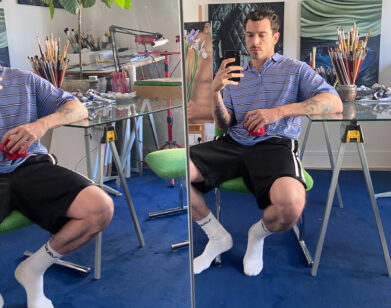Matthew Barney and Jonathan Bepler
A performance still from “Khu” by Matthew Barney and Jonathan Bepler, October 2, 2010. Photo: Hugo Glendinning/courtesy Gladstone Gallery, New York.
My interest in dance has to do with the basic drama of an object in space, inter acting with gravity, and the potential for the object to fall over or to fail. The fundamental stuff of sculpture . . . And of physical comedy, too.Matthew Barney
On October 2, 2010, something weird and otherworldly visited downtown Detroit. It was the second chapter of the seven-part performance piece Ancient Evenings, loosely based on Norman Mailer’s 1983 novel and created (with resurrectionist fervor) by artist Matthew Barney and composer Jonathan Bepler. Barney, best known for his cinematic Cremaster Cycle series, seems to have reversed gears in his production tactics lately—the end product is the live performance, while the filmed documentations of these mesmeric artistic rites serve as secondary artifacts. Each of Ancient Evening’s seven acts tackles a different stage of the soul’s transformation from death to rebirth—in accordance with Egyptian mythology (or at least Mailer’s retelling of it). Those who happened to be present at a certain south Los Angeles car dealership in May 2008 might have witnessed the release of the “REN”—or a person’s secret name—which, in the phantasmagoric retinal and audio landscape of the Barney and Bepler collaboration, involved a funereal procession and violent destruction of a green 1967 Chrysler Crown Imperial before it was mystically reincarnated into a gold 1979 Pontiac Firebird Trans Am. The setting of Los Angeles—where private selves so often die to be reborn as sparkling golden icons— seemed an ominous but winking gesture.
For the second act, Barney and Bepler’s pit stop was Detroit, where an entirely different frisson applied. Two hundred audience members gathered downtown that morning to watch the departure of the “KHU” or light. But Detroit is not Los Angeles—the Motor City hardly has the same sense of sunny optimism and quick cultural resurrection. Much of Detroit is an endless, vacant inner city, its exquisite Art-Deco towers abandoned, shattered, or just blazed out. It is a city with no real sense of impending salvation. Fittingly, the weather on the day of “KHU” was cold and rainy, leaving audience members to endure the harsh outside conditions for the entirety of the seven-plus-hour performance. Of course, the mash-up of other historic factors also made Detroit optimal: As cars feature so prominently in Ancient Evenings, the hub of American automobile manufacturing was clearly significant (artist Diego Rivera painted a series of murals depicting the Ford assembly lines in the Detroit Institute of Art, which served as the initial starting line for “KHU”); Harry Houdini performed his first handcuffed bridge jump off the Belle Island Bridge into the Detroit River in 1906 and later died in a Detroit hospital from a ruptured appendix in 1926; and influential performance artist James Lee Byars, who once “performed” his own death, was from Detroit. Death was everywhere in “KHU,” but this morbid intrigue took on stunning twists and turns. Early on, at an abandoned glue factory, assembly-line machinists turned steel sheets into 16 working viols, which were played by musicians in a mournful aria before Detroit blues singer Belita Woods belted out incantations from The Egyptian Book of the Dead. The audience was then packed onto a barge, which floated down the Rouge and Detroit Rivers and eventually stumbled upon a crime-scene investigation on the shoreline. Actress Aimee Mullins played an FBI detective who also happens to be an incarnation of the goddess Isis, and soon, as four towboats loaded with musicians circled the barge, the cadaver of the Chrysler from “REN” was pulled from the river. In turns, the car’s remains were autopsied on deck, separated like mummified organs, allowing Isis the opportunity to have sex with the engine—notably filled with live snakes—before being taken into custody herself by two twin baritones. The car’s body was lifted off the barge, cut into pieces, and as the audience stood after sunset in the rain on a platform in front of a steel mill shooting sparks, the pieces of the Chrysler were eventually melted into molten liquid—no doubt to be incorporated into a future chapter. Before the act could be completed, the operators of the furnaces shut down the event for fear of explosions. But for those watching, the narrative plot points mattered less than the brilliant momentary interactions and interventions that the framework held. Where “REN” felt like an ensemble of elegiac marching tunes, everything about “KHU” was operatic.
Barney, of course, has become the art-world Houdini of visual spectacle, but Ancient Evenings is really very much a musical event. The live performance was primed as much for its radical image content as for its opportunity to break new ground in the ear. Barney and his collaborator Bepler, who is based in Berlin, talk here about the sound of Ancient Evenings. But first the 43-year-old artist explains in his own words how he and the composer first met and why Bepler, age 51, builds an ongoing soundtrack that is the opposite of background noise.
“Peter Strietmann, the cinematographer of the Cremaster project, introduced me to Jonathan Bepler during the postproduction of Cremaster 1 in 1995. I realized I couldn’t finish that soundtrack using only found public-domain music from the 1930s, as I had originally planned. I needed a piece to be written to bridge two scenes, and Jonathan agreed to do this, though there was little space for him to express his own language. At that time, I was thinking about sound design more in terms of site-specificity and the ready-made aspect of the work. In the same way that my visual language was coming from the landscape and traditions of where the work was made, there was also an abundance of sound—both ambient and traditional— that came along with each of these locations. It hadn’t occurred to me to work with a composer, partially because I didn’t believe in it. In my mind, soundtrack music belonged to the language of film (and Cremaster did not), and was a layer of emotion that was applied, which didn’t interest me. It was inspiring to meet a composer who felt the same way, and those first discussions with Jonathan led to the development of Cremaster 5, which we did together in 1997. During the production of C5, we established a way of working that involved writing the visual narrative and the musical composition simultaneously. This opened up a number of new possibilities. Around that time we started talking about a mutual interest in making a live work together. This idea was kicked around for a number of years, and with Ancient Evenings, we are finally getting around to it.”
If trying to achieve a kind of ecstasy involves having to trample on certain moralities on the way, then I am definitely driven by nihilism.Jonathan Bepler
MATTHEW BARNEY: You and I have collaborated on projects over the last 14 years, so we know each other’s habits pretty well. That said, I’ve never directly asked you some of the questions I’m about to ask, and I’m so curious to hear how you will answer. First, what does dissonance mean to you?
JONATHAN BEPLER: Well, musical dissonance is thought of as tones happening at the same time that feel unstable, and this is considered unpleasant. Cognitive dissonance is the idea of holding opposing thoughts at the same time, which is also thought to be uncomfortable. Through the years, especially when communicating ideas to musicians, I’ve learned that I have a different idea of how comfortable these things are than many people. I really love these unstable states, as they suggest infinite possibilities. I love these kinds of sounds.
BARNEY: Do you think consciously while you are writing about putting that kind of pressure on the listener?
BEPLER: Definitely.
BARNEY: Are you driven by nihilism, or a disdain for the listener—or for people in general?
BEPLER: I love all people, really. And I love to make them squirm if possible. It excites me to be challenged by music—to be slightly tortured, then lulled; to be swallowed up. I want them to feel that, too. Fuck you! If trying to achieve a kind of ecstasy involves having to trample on certain moralities on the way, then I am definitely driven by nihilism, yes.
BARNEY: I’ve noticed that you shy away from using words like noise and atonality. Why is that?
BEPLER: Probably because I don’t know what they mean. Seriously, I think all sound is music, so there’s no such thing as noise. I admit that I am prejudiced against tonality, and my training is also against it. But I associate atonality with a certain kind of modernism, which to me is all about accepting tonality, then breaking with it in a somewhat petty way. I don’t think I’m trying to break with tonality, but trying to reach some kind of unknown ideal. I always begin with the perhaps foolish idea that this next thing or work will finally break through to the next dimension. That we can all free ourselves from our stasis.
BARNEY: I know that one of your interests in performance is to find a way that music can really exist within a scene, as part of its fundamental structure and behavior, rather than merely as its accompaniment. Can you talk about the challenge to achieve this in live performance versus, say, film?
BEPLER: I’ve found that the way to do this in film is to be involved in the making before things are even shot—to get the music into the system, into the picture somehow, as was the case in the Cremaster films, where the actors are often performing the music and sound live on screen. I suppose in live performance it’s the same. Are the musicians standing on the side or are they involved in the action? Musicians standing on the side is like background music in film. I guess you are supposed to forget they are there. They say in film, music is really working if you’re not aware of it. It works its way into the emotion of the scene. This sounds fine, but this is only one of a hundred ways music could be working. I personally like it when it does many things at once, and has a real agency, a character, of its own—a oneness that’s inseparable.
BARNEY: In “KHU,” we decided to add some classical singers into the mix, and even a pair of proper opera performers, with Eugene and Herbert Perry. How close do you feel to opera as a discipline?
BEPLER: As a composer, I would love to contribute to that “literature.” In the sense of it being a “total artwork,” with many media existing together, I feel very connected to it. I guess film is the thing that plays this role now in our culture. But it’s become pretty predictable, even in the experimental realm. You can be sure nothing will jump out of the screen and get you! That’s why opera might feel more interesting now. I also love the stage, and the whole machine behind it, though a stage might not be big enough to hold some of the best ideas.
BARNEY: Have you ever seen an opera that you felt completely connected to?
BEPLER: Umm. No.
BARNEY: Me neither.
BEPLER: I’ve had plenty of these sentimental connections, which have to do with being touched by a piece of music that connects to what you are going through at that particular time in your life. Some aria moments have got me pretty good. The romance! The emotion! Some of Peter Sellars’s work with Mozart operas was a great synthesis of old and new. I probably feel more connected with the dance form, maybe because I feel most comfortable with dancers and choreographers. I realize I don’t get out enough to see things, though.
BARNEY: I feel more connected to dance, as well. More so than to theater or opera, for sure. It’s interesting that we share that—although where we meet is closer to the language of opera. I think my interest in dance has to do with the basic drama of an object in space, interacting with gravity, and the potential for the object to fall over or to fail. The fundamental stuff of sculpture—and of physical comedy, too. On the Detroit project I became more aware of your relationship to drawing and mapping, and the way you choreograph the musicians in a scene while you are writing the music for them. Can you talk about your notation?
BEPLER: I’ve been really excited by working with moving sounds, so I often ask musicians to move through space. I want them walking or running, or on a vehicle while playing music. It’s another dimension, which cannot be shown in staff notation, so I’ve got into these little graphical scores with diagrams of the performers—a kind of frame-by-frame storyboard with arrows and things. I get laughed at for this, but I haven’t shown them to any dancer friends.
BARNEY: I have worked with a pretty broad range of artists and practitioners from different disciplines, and you are by far the most organic thinking person I’ve ever worked with. I’m guessing it might be difficult to capture how open-ended your process is in this conversation, but let’s try. Can you talk about the musical anatomy of what we just performed in Detroit?
BEPLER: For the metal viols during the metalin overture at the assembly line, the initial idea for those instruments came when we were planning to do the piece 1,000 feet underground in a mine. I’d wanted to use a string ensemble as accompaniment for an aria by one of the characters in the final scene where there is a light at an opening in the cavern and the “KHU” bird flies toward it. The atmosphere in the mine was so hot and damp that normal violas would just fall apart. So the idea to use metal instruments came up. Later, when the piece was to be in Detroit, we visited assembly lines and stamping plants. These lower-tech plants where sheet metal is stamped into car parts were pretty compelling, and I wondered how this might fit the piece, soundwise. The idea of seeing the instruments constructed came from this. It would be a working situation that gradually transforms into a recital, which then moves into a concert when the singer enters.
BARNEY: This is a good example of one of a number of scenes in Ancient Evenings, which have an undetermined duration. These scenes are often unrepeatable, and therefore cannot be rehearsed. You have written for these scenes in a modular way, to keep the duration flexible. Can you talk about how this worked in the metalin overture?
BEPLER: If the duration and rhythm of the musical piece were to work with the construction of the instruments, then the addition of the musical parts would be determined by the rate of production output. So, instead of a new metalin entering every 14 measures, it had to be a new metalin enters every one to two minutes. This meant the piece had to be written so it could last anywhere between 20 to 30 minutes. The singer’s part would then fall somewhere in the last four minutes. The piece had to be a kind of process, which could be shaped as it went, depending on the assembly. The tuning of these instruments was also worked into the composition. The trombone chorale playing from the basement could be cued in to wash everything out and make an ending shift.
BARNEY: Watching you work in your studio, during those first projects we made together in the mid- ’90s, made me understand how the computer could function as an organic tool within one’s artistic practice. The computer is like a lump of clay for you. The visual interface of some of the music programs you use seem to play heavily into your writing and editing process. How does the computer play a part in the way you write?
BEPLER: I would much rather work with people! But it’s not like Mahler with his orchestra always in front of him. I find I’m mostly trying to get music software to do what it doesn’t want to do—finding ways to trick it into something. But computers are so convenient, and at a certain point you just say, “Okay, I’ll do it your way.” But I’m always a bit ashamed when the music changes to fit the notation, rather than vice versa. It’s so tempting to listen to the samples played on the computer, and to compose for that. It takes experience to ignore that and to know what it really will sound like when you finally take it to real musicians.
BARNEY: I feel that your improvisational spirit is one of the most significant ingredients in Ancient Evenings. It affects everything in the project, not just the music . . . from the general production coordination to the more specialized labor force. It’s interesting to watch you defend the possibility of things remaining open-ended as long as possible. Would you define your way of working as belonging to the tradition of improvisation?
BEPLER: The paradox is that improvisation is all about making quick decisions on the fly, not just hanging out and blowing free (and I have done a lot of work on improvisation as a performer in the past). But you do get to create things right there in the moment, where everything can be near perfect as it is happening, as though it couldn’t have been any other way. With composition, I do have a fear of the moment where you commit to something on paper, and thus suddenly rule out all of the other amazing things that could have happened. That’s painful. Especially in collaboration where you don’t know yet exactly how the setting will feel. I spend a lot of time researching and thinking about exactly who should be playing, where, and why. It seems crucial to know this before any notes can be committed. I do have the experience of writing a piece of music, which becomes an object, and then to have the situation change and the music feels pasted on somehow. Or maybe it just feels dead because I know there will be no big surprises. The thing about improvisation is that it’s full of surprises to the point where it feels like it’s coming from somewhere else. Like a kind of channeling, I guess. Like it’s a part of nature. Much more essential than someone’s intellectual efforts. Including mine. I want to be a part of nature.
BARNEY: In our collaboration, where do you feel like you and I meet most naturally, and where do you feel we differ most significantly?
BEPLER: I think we have really grown into a similar sensibility toward many things. This sense of “edge” that we immediately agree on and don’t even have to talk about, for example. And a sense of humor. And probably a desire for expansion and not paring down, is that safe to say? For example, Ancient Evenings was a one-evening piece when we started on it, and by the next day it had expanded so each act was at a different location over the course of years. We also have ongoing contrasts, which I think keeps the energy interesting. You seeing what you want clearly, and me wanting to mix it up until something jumps out, for example. Or you hating human presentation and me hating physical presentation. But I really like when we are working on a situation and we are seeing it very differently from each other, but doing our work in parallel. Occasionally we get surprised and say, “What the fuck are you thinking?” In the end, the disagreement is very complementary.
BARNEY: I’m always surprised that there is not more said about the sense of humor you mentioned. It’s pretty fundamental to our collaboration. Do you think the humor is abstracted to the point that it’s difficult for others to locate?
BEPLER: Well, it could be that humor lives in abstraction. I’m often impressed how weird some comic material is, for example. But abstraction is usually taken seriously, which is not funny!
BARNEY: Are adult human beings, in your opinion, overdetermined?
BEPLER: What does that mean? Too many motivations at once?
BARNEY: I guess I mean overly motivated to make things concrete.
BEPLER: Yes, I definitely think they are. But most times I have the feeling I don’t really know what it means to be an adult.
BARNEY: What interests you more, child behavior or animal behavior?
BEPLER: I have tried to be an animal for many years, with some limited success. I have watched children grow up and have had to scold them over and over— for their own good. But I have been longing for the countryside for practically all of the 20 years I’ve been living in cities, so I would like to see some real nests.







